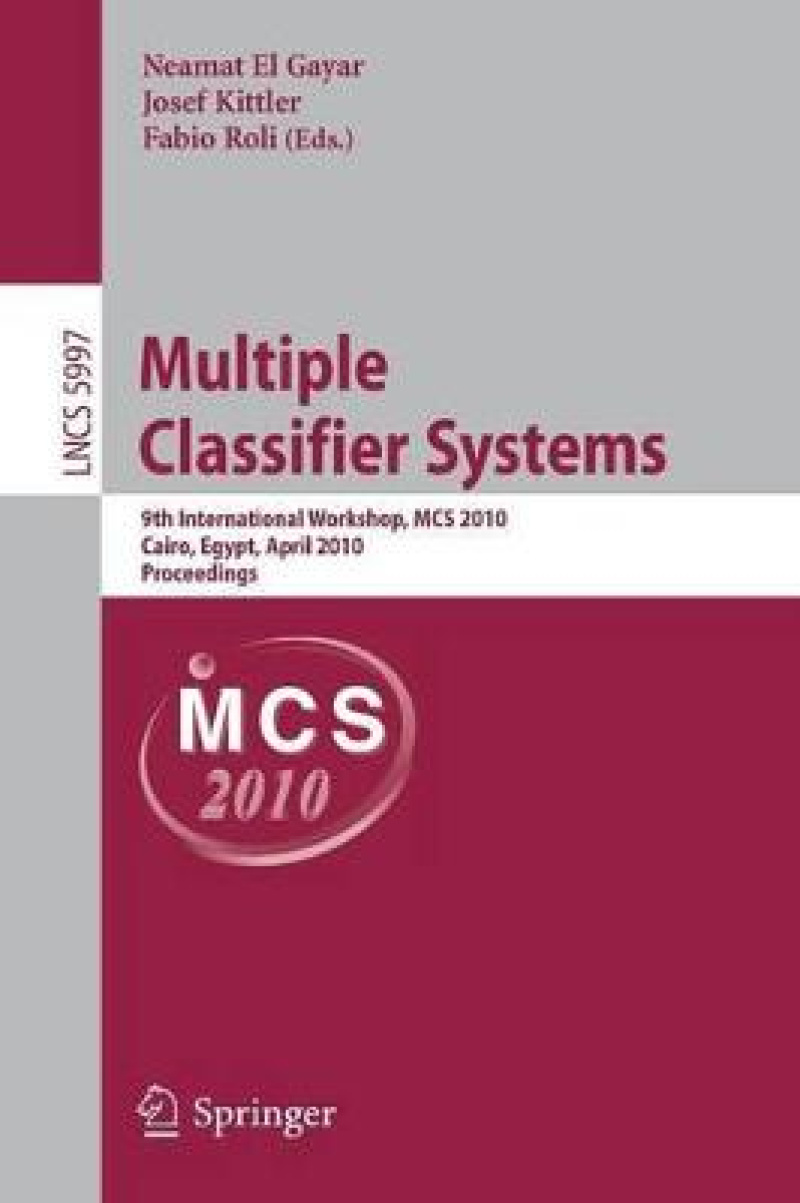These proceedings are a record of the Multiple Classi?er Systems Workshop, MCS 2010, held at the Nile University, Egypt in April 2010. Being the ninth in a well-established series of meetings providing an international forum for d- cussion of issues in multiple classi?er system design, the workshop achieved its objective of bringing together researchers from diverse communities (neural n- works, pattern recognition, machine learning and statistics) concerned with this researchtopic.Frommorethan50submissions,theProgramCommitteeselected 31 papers to create an interesting scienti?c program.Paperswere organizedinto sessionsdealingwithclassi?ercombinationandclassi?erselection,diversity,b- ging and boosting, combination of multiple kernels, and applications. The wo- shopprogramandthisvolumewereenrichedbytwoinvitedtalksgivenbyGavin Brown(University of Manchester,UK), and Friedhelm Schwenker(University of Ulm, Germany). As usual, the workshop would not have been possible without the help of many individuals and organizations.
First of all, our thanks go to the members of the MCS 2010 Program Committee, whose expertise and dedication helped us create an interesting event that marks the progressmade in this ?eld overthe last year and aspire to chart its future research. The help of James Field from the University of Surrey, who administered the submitted paper reviews, and of Giorgio Fumera who managed the MCS website deserve a particular mention. Special thanks are due to the members of the Nile University Organizing C- mittee,AhmedSalah,AmiraElBaroudy,EsraaAly,HebaEzzat,NesrineSameh, Rana Salah and Mohamed Zahhar for their indispensable contributions to the registration management, local organization, and proceedings preparation.
Les mer
Constitutes the proceedings of the 9th International Workshop on Multiple Classifier Systems, MCS 2010, held in Cairo, Egypt, in April 2010. This book includes contributions that are organized into sessions dealing with classifier combination and classifier selection, diversity, bagging and boosting, and combination of multiple kernels.
Les mer
Classifier Ensembles(I).- Weighted Bagging for Graph Based One-Class Classifiers.- Improving Multilabel Classification Performance by Using Ensemble of Multi-label Classifiers.- New Feature Splitting Criteria for Co-training Using Genetic Algorithm Optimization.- Incremental Learning of New Classes in Unbalanced Datasets: Learn?+?+?.UDNC.- Tomographic Considerations in Ensemble Bias/Variance Decomposition.- Choosing Parameters for Random Subspace Ensembles for fMRI Classification.- Classifier Ensembles(II).- An Experimental Study on Ensembles of Functional Trees.- Multiple Classifier Systems under Attack.- SOCIAL: Self-Organizing ClassIfier ensemble for Adversarial Learning.- Unsupervised Change-Detection in Retinal Images by a Multiple-Classifier Approach.- A Double Pruning Algorithm for Classification Ensembles.- Estimation of the Number of Clusters Using Multiple Clustering Validity Indices.- Classifier Diversity.- “Good” and “Bad” Diversity in Majority Vote Ensembles.- Multi-information Ensemble Diversity.- Classifier Selection.- Dynamic Selection of Ensembles of Classifiers Using Contextual Information.- Selecting Structural Base Classifiers for Graph-Based Multiple Classifier Systems.- Combining Multiple Kernels.- A Support Kernel Machine for Supervised Selective Combining of Diverse Pattern-Recognition Modalities.- Combining Multiple Kernels by Augmenting the Kernel Matrix.- Boosting and Bootstrapping.- Class-Separability Weighting and Bootstrapping in Error Correcting Output Code Ensembles.- Boosted Geometry-Based Ensembles.- Online Non-stationary Boosting.- Handwriting Recognition.- Combining Neural Networks to Improve Performance of Handwritten Keyword Spotting.- Combining Committee-Based Semi-supervised and Active Learning and Its Application toHandwritten Digits Recognition.- Using Diversity in Classifier Set Selection for Arabic Handwritten Recognition.- Applications.- Forecast Combination Strategies for Handling Structural Breaks for Time Series Forecasting.- A Multiple Classifier System for Classification of LIDAR Remote Sensing Data Using Multi-class SVM.- A Multi-Classifier System for Off-Line Signature Verification Based on Dissimilarity Representation.- A Multi-objective Sequential Ensemble for Cluster Structure Analysis and Visualization and Application to Gene Expression.- Combining 2D and 3D Features to Classify Protein Mutants in HeLa Cells.- An Experimental Comparison of Hierarchical Bayes and True Path Rule Ensembles for Protein Function Prediction.- Recognizing Combinations of Facial Action Units with Different Intensity Using a Mixture of Hidden Markov Models and Neural Network.- Invited Papers.- Some Thoughts at the Interface of Ensemble Methods and Feature Selection.- Multiple Classifier Systems for the Recogonition of Human Emotions.- Erratum.- Erratum.
Les mer
Fast track conference proceedings State of the art papers in multiple classifier systems Up to date research
GPSR Compliance
The European Union's (EU) General Product Safety Regulation (GPSR) is a set of rules that requires consumer products to be safe and our obligations to ensure this.
If you have any concerns about our products you can contact us on ProductSafety@springernature.com.
In case Publisher is established outside the EU, the EU authorized representative is:
Springer Nature Customer Service Center GmbH
Europaplatz 3
69115 Heidelberg, Germany
ProductSafety@springernature.com
Les mer
Produktdetaljer
ISBN
9783642121265
Publisert
2010-03-25
Utgiver
Springer-Verlag Berlin and Heidelberg GmbH & Co. KG; Springer-Verlag Berlin and Heidelberg GmbH & Co. K
Aldersnivå
Research, P, 06
Språk
Product language
Engelsk
Format
Product format
Heftet

